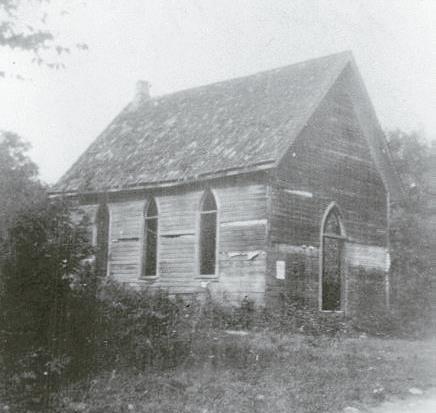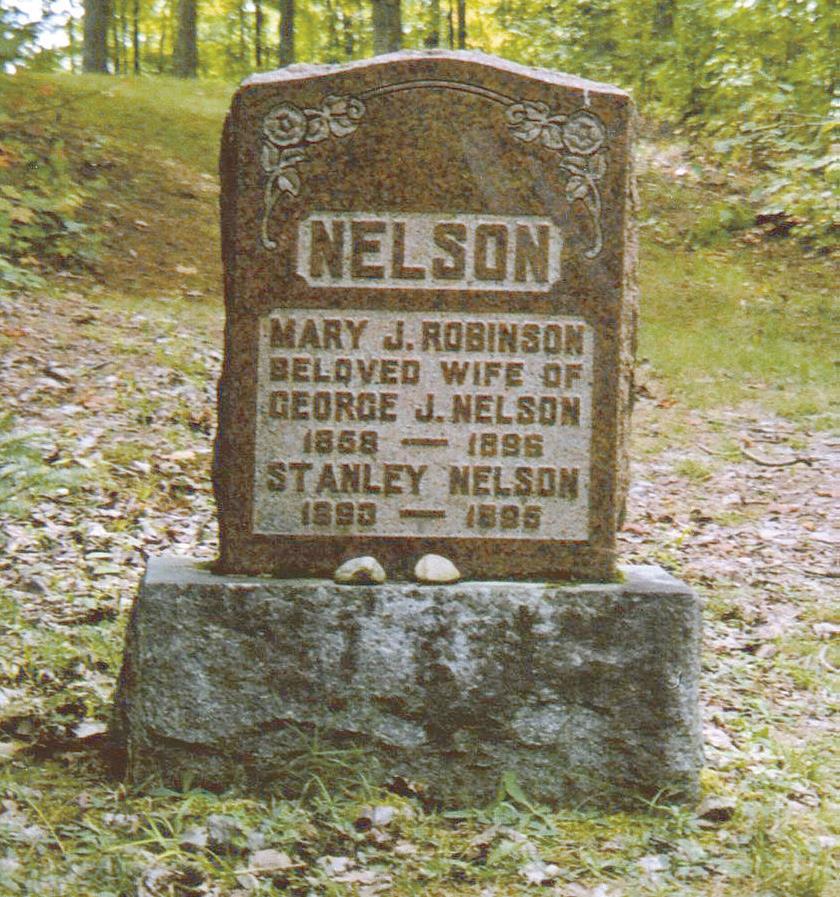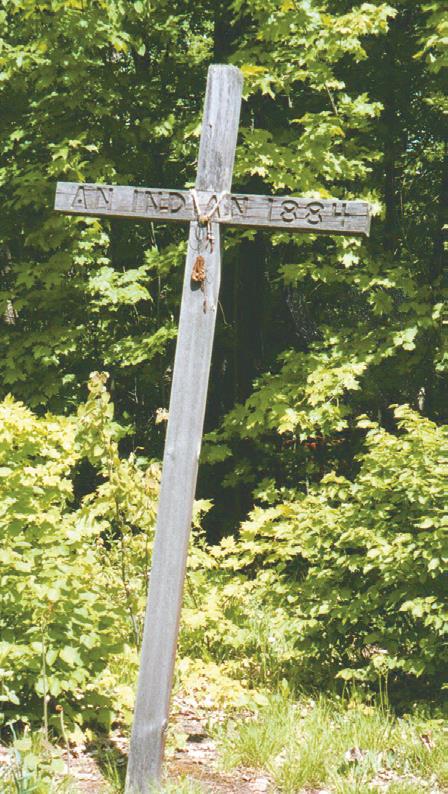By Barbara Paterson
 |
|
Mizpah Church
|
From “Stories of the Past,” Muskoka Sun, October 11, 2007; The Sinclair Raconteur’s Anthology: Barbara Paterson’s Published Stories, eds. W. Dan Mansell, Carolyn Paterson, and Marlene Walker (Peterborough: asiOtus Natural Heritage Consultants, 2014).
Republished with permission of Metroland North Media and asiOtus natural heritage consultants.
In late 1885, despite William Swain’s objections, a road was built from the schoolhouse in the fourth concession of Sinclair township across William Nelson’s and William Swain’s land to circumvent the originally surveyed “mountainous” right-of-way between the fourth and fifth concessions that ended at the Bobcaygeon Road. The new diversion, where it crossed Nelson’s Creek at the end of Rebecca Lake, was just beyond a hill that offered a lovely view down the lake. It was this location, on a corner of William Nelson’s land, that the people of the area had chosen for a burial ground.
The community was known as Nelson’s Appointment and was one of four locations in the Hillside Mission of the Methodist church where as many as 25 families attended church services in the local schoolhouse. In November 1894, it was decided to build a church on what was known as Park Road in a grove near the graveyard. The new church, named Mizpah, was opened Jan. 5, 1896.
Although there were burials here for a period of about 20 years, between 1885 and 1905, other than the inscriptions on the six commercial stone monuments, there are no burial records for this little pioneer cemetery. Any wooden crosses, which marked some of the graves, have disappeared long ago and the original cedar rail fence that enclosed the graveyard is barely visible way down over the hill near Nelson’s Creek. Those whose final resting place is here were members of the families who were a part of an active rural landscape and who, with one exception, had all moved away by 1910.
For many years, all was peaceful and quiet at Mizpah, as it gradually became overgrown. One dark night as Frank Hutcheson was returning from a fishing trip at his family camp on Dotty Lake, he was startled as he passed the little cemetery. A ghostly figure, carrying a lantern and waving his arm to get Frank’s attention, was hurrying toward him. It was the Huntsville undertaker dressed in his nightshirt and nightcap. Fresh out of matches, he was hoping Frank had a few to give him for his breakfast fire. The man was camping in the deserted church overnight and the next day he would be exhuming the remains of Mr. and Mrs. Argue, to be sent to Saskatchewan where their son now lived. When Hutcheson Memorial Cemetery in Huntsville was opened in 1936, the undertaker returned to Mizpah once more to exhume and reinter the remains of Annie McBrien in the new cemetery that offered perpetual care.
By 1930, there was again a need for a school in the area, as Limberlost, Oxbow Lodge and Fieldale joined Camp Billie Bear to become busy local tourist resorts. Gordon Hill of Limberlost and Eli Birtch, farm manager for William Mansell on the old Nairn, then Hart, farm, arranged to have the abandoned church dismantled and the material used to build a little frame schoolhouse across the road from the original school that had burned many years before.
With the Mizpah church gone, the gravel deposit under it was exposed and readily accessible. It didn’t take long for Park Road to disappear and a depth of 30 feet of the hill with it. A resident was passing by one day and saw a monument topple into the rubble below as a bulldozer literally undermined the edge of the cemetery. Over the years, the hill along the main road became eroded and washed out in heavy rains and graves were exposed. By 1950, Mizpah had become second fiddle, being referred to as “the old cemetery near the gravel pit.”
About 1938, Hugh Hill of Friendly Acres at Hillside established a sawmill at the east end of Rebecca Lake and Edgar Brook became his partner. Edgar’s wife, the former Mabel Hart, was the only member of the original settlers’ families still in the area. She had founded Camp Billie Bear on Bella Lake in 1906 and in 1945 had sold the resort and retired to live at Brook’s Mill.
In 1955, Norman Nelson contacted Mabel from his home at Port Reeve, Saskatchewan. Norman was the son of George and Mary Ann Nelson and had been born in Sinclair township in 1885 at his family’s farm across the road from the first school. He was 11 years old when he left with his father and siblings for the west, very shortly after his mother’s death on April 4, 1897. She had died of tuberculosis at 38 years of age. Now a successful retired farmer, Norman was fulfilling a lifelong dream to place a monument at the site of his mother’s grave. When he came, he recognized none of the old landmarks, but with Mabel’s help, he located the spot where his mother had been buried almost 60 years earlier. Norman’s younger brother Stanley was also commemorated on a new granite monument.
 |
 |
|
|
Mary Jane Nelson’s Monument. |
“An Indian 1884” |
Norman Nelson’s visit prompted a lot of activity at Mizpah. Mainly through Mabel’s efforts, part of the old cemetery was cleared and tidied. A social evening to raise funds was held at the schoolhouse, by then the community centre (local students were being bused to school in Huntsville by then). Hugh Hill was master of ceremonies and Mabel Brook and her friend May Wilson provided refreshments. Nancy Pugh, a cottager from Bella Lake, led the singing and Graham Atkin, then owner of Billie Bear Resort, and his guests, Mr. Rockcliffe and Miss Matthews, gave a picture show of scenes taken throughout the area. Mr. Osgoode, a cottager from Limberlost, and Jimmy Reesor, a guest at Billie Bear, also helped. The evening raised $60 to help with the clearing. Mabel Brook died in 1963, but Jack and Bobbie Welsh [a daughter of Gordon and Marion Hill of Limberlost] continued to improve the Mizpah cemetery. It was they who fashioned the archway that incorporated the name and erected an interpretive board.
Since new provincial regulations, put in place in the 1990s, the Township of Lake of Bays has been responsible for keeping the grass cut in the area where the monuments can be seen. Local cottagers continue to keep a watchful eye on this special place, the only visible remainder of those few short years when Nelson’s Appointment was a struggling agricultural community.
|
|
||
|
|
|
|
|



